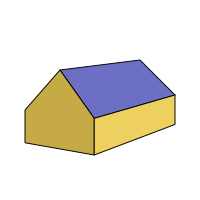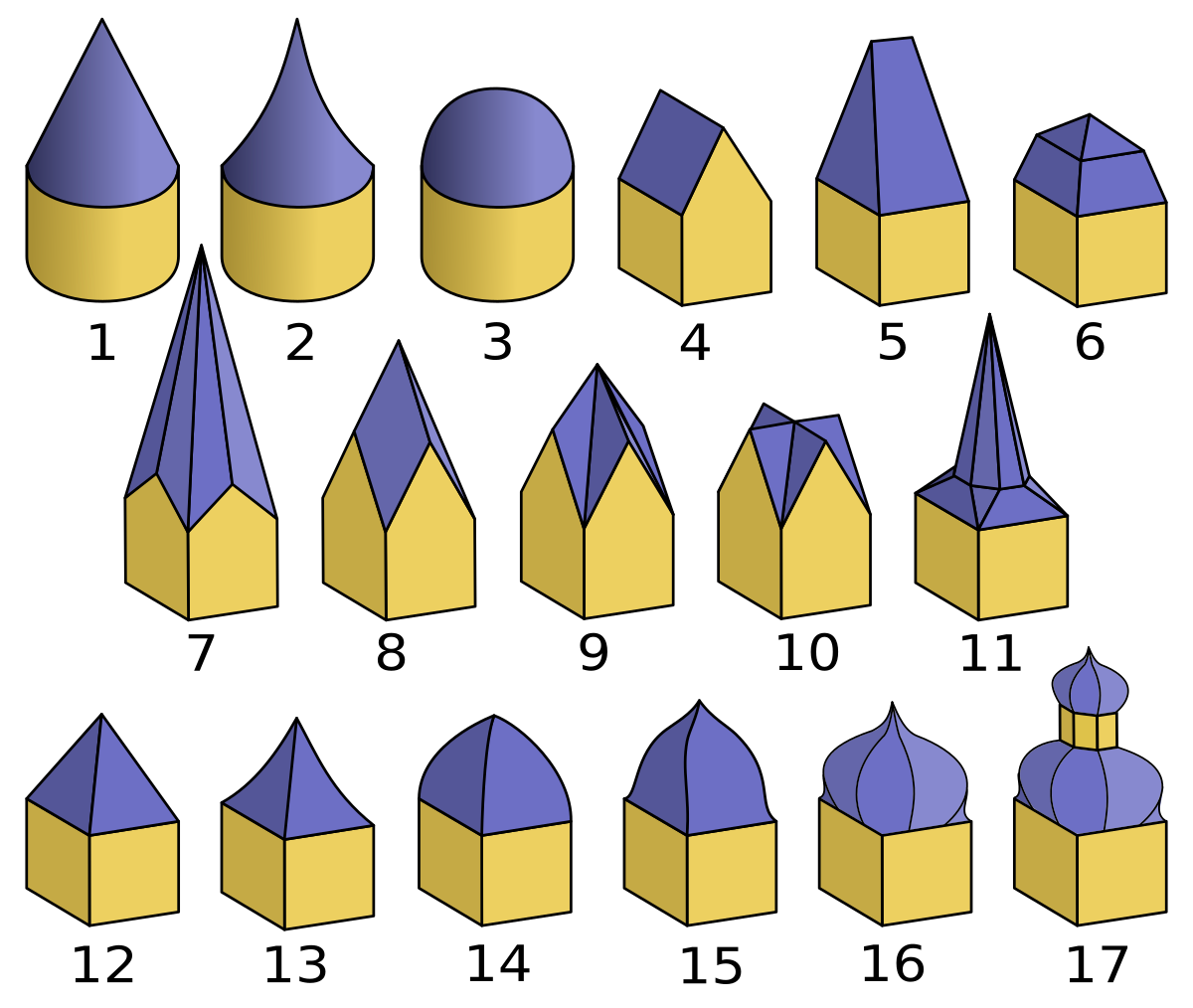|
Mono-pitched Roof
A shed roof, also known variously as a pent roof, lean-to roof, outshot, catslide, skillion roof (in Australia and New Zealand), and, rarely, a mono-pitched roof,Cowan, Henry J., and Peter R. Smith. ''Dictionary of Architectural and Building Technology''. 4th ed. London: Spon Press, 2004. Print. is a single-pitched roof surface. This is in contrast to a dual- or multiple-pitched roof. An outshot or catslide roof is a pitched extension of a main roof similar to a lean-to but an extension of the upper roof. Some Saltbox homes were created by the addition of such a roof, often at a shallower pitch than the original roof. Applications A single-pitched roof can be a smaller addition to an existing roof, known in some areas as a lean-to roof. Single-pitched roofs are used beneath clerestory windows. One or more single-pitched roofs can be used for aesthetic consideration(s). A form of single-pitched roof with multiple roof surfaces is the sawtooth roof A saw-tooth roof ... [...More Info...] [...Related Items...] OR: [Wikipedia] [Google] [Baidu] |
Australia
Australia, officially the Commonwealth of Australia, is a Sovereign state, sovereign country comprising the mainland of the Australia (continent), Australian continent, the island of Tasmania, and numerous List of islands of Australia, smaller islands. With an area of , Australia is the largest country by area in Oceania and the world's List of countries and dependencies by area, sixth-largest country. Australia is the oldest, flattest, and driest inhabited continent, with the least fertile soils. It is a Megadiverse countries, megadiverse country, and its size gives it a wide variety of landscapes and climates, with Deserts of Australia, deserts in the centre, tropical Forests of Australia, rainforests in the north-east, and List of mountains in Australia, mountain ranges in the south-east. The ancestors of Aboriginal Australians began arriving from south east Asia approximately Early human migrations#Nearby Oceania, 65,000 years ago, during the Last Glacial Period, last i ... [...More Info...] [...Related Items...] OR: [Wikipedia] [Google] [Baidu] |
New Zealand
New Zealand ( mi, Aotearoa ) is an island country in the southwestern Pacific Ocean. It consists of two main landmasses—the North Island () and the South Island ()—and over 700 smaller islands. It is the sixth-largest island country by area, covering . New Zealand is about east of Australia across the Tasman Sea and south of the islands of New Caledonia, Fiji, and Tonga. The country's varied topography and sharp mountain peaks, including the Southern Alps, owe much to tectonic uplift and volcanic eruptions. New Zealand's capital city is Wellington, and its most populous city is Auckland. The islands of New Zealand were the last large habitable land to be settled by humans. Between about 1280 and 1350, Polynesians began to settle in the islands and then developed a distinctive Māori culture. In 1642, the Dutch explorer Abel Tasman became the first European to sight and record New Zealand. In 1840, representatives of the United Kingdom and Māori chiefs ... [...More Info...] [...Related Items...] OR: [Wikipedia] [Google] [Baidu] |
Roof
A roof ( : roofs or rooves) is the top covering of a building, including all materials and constructions necessary to support it on the walls of the building or on uprights, providing protection against rain, snow, sunlight, extremes of temperature, and wind. A roof is part of the building envelope. The characteristics of a roof are dependent upon the purpose of the building that it covers, the available roofing materials and the local traditions of construction and wider concepts of architectural design and practice, and may also be governed by local or national legislation. In most countries, a roof protects primarily against rain. A verandah may be roofed with material that protects against sunlight but admits the other elements. The roof of a garden conservatory protects plants from cold, wind, and rain, but admits light. A roof may also provide additional living space, for example, a roof garden. Etymology Old English 'roof, ceiling, top, summit; heaven, sky', also f ... [...More Info...] [...Related Items...] OR: [Wikipedia] [Google] [Baidu] |
Gabled Roof
A gable roof is a roof consisting of two sections whose upper horizontal edges meet to form its ridge. The most common roof shape in cold or temperate climates, it is constructed of rafters, roof trusses or purlins. The pitch of a gable roof can vary greatly. Distribution The gable roof is so common because of the simple design of the roof timbers and the rectangular shape of the roof sections. This avoids details which require a great deal of work or cost and which are prone to damage. If the pitch or the rafter lengths of the two roof sections are different, it is described as an 'asymmetrical gable roof'. A gable roof on a church tower (gable tower) is usually called a 'cheese wedge roof' (''Käsbissendach'') in Switzerland. Its versatility means that the gable roof is used in many regions of the world. In regions with strong winds and heavy rain, gable roofs are built with a steep pitch in order to prevent the ingress of water. By comparison, in alpine regions, gable roo ... [...More Info...] [...Related Items...] OR: [Wikipedia] [Google] [Baidu] |
List Of Roof Shapes
Roof shapes include flat (or shed), gabled, hipped, arched, domed, and a wide variety of other configurations detailed below. Roof angles are an integral component of roof shape, and vary from almost flat to steeply pitched. Roof shapes differ greatly from region to region, depending on the climate, materials available, customs, and many other considerations. Roof terminology is not rigidly defined. Usages vary from region to region, nation to nation, and from one builder or architect to another. Roof shapes * Flat: These are found in traditional buildings in regions with a low precipitation. Modern materials which are highly impermeable to water make possible the low-pitch roofs found on large commercial buildings. Although referred to as flat they are generally gently pitched. ** Roof terrace (including roof garden) * Single-pitched roof ** Shed roof (lean-to, pent roof, skirt roof, outshot, skillion, mono-roof): A roof with one slope, historically attached to a taller ... [...More Info...] [...Related Items...] OR: [Wikipedia] [Google] [Baidu] |
Saltbox
A saltbox house is a gable-roofed residential structure that is typically two stories in the front and one in the rear. It is a traditional New England style of home, originally timber framed, which takes its name from its resemblance to a wooden lidded box in which salt was once kept. The structure's unequal sides and long, low rear roofline are its most distinctive features. A flat front and central chimney are also recognizable traits. Origins The saltbox originated in New England and is an example of American colonial architecture. Its shape evolved organically as an economical way to enlarge a house by adding a shed to a home's rear. Original hand-riven oak clapboards are still in place on some of the earliest New England saltboxes, such as the Comfort Starr House and Ephraim Hawley House. Once part of their exteriors, they are preserved in place in attics that were created when shed-roofed additions were added onto the homes. The style was popular for structures throug ... [...More Info...] [...Related Items...] OR: [Wikipedia] [Google] [Baidu] |
Roof Pitch
Roof pitch is the steepness of a roof expressed as a ratio of inch(es) rise per horizontal foot (or their metric equivalent), or as the angle in degrees its surface deviates from the horizontal. A flat roof has a pitch of zero in either instance; all other roofs are pitched. A roof that rises 3 inches per foot, for example, would be described as having a pitch of 3 (or “3 in 12”). Description The pitch of a roof is its vertical 'rise' over its horizontal 'run’ (i.e. its span), also known as its 'slope'. In the imperial measurement systems, "pitch" is usually expressed with the rise first and run second (in the US, run is held to number 12; e.g., 3:12, 4:12, 5:12). In metric systems either the angle in degrees or rise per unit of run, expressed as a '1 in _' slope (where a '1 in 1' equals 45°) is used. Where convenient, the least common multiple is used (e.g., a '3 in 4' slope, for a '9 in 12' or '1 in 1 1/3'). Selection Considerations involved in selecting a roof ... [...More Info...] [...Related Items...] OR: [Wikipedia] [Google] [Baidu] |
Lean-to
A lean-to is a type of simple structure originally added to an existing building with the rafters "leaning" against another wall. Free-standing lean-to structures are generally used as shelters. One traditional type of lean-to is known by its Finnish name . Lean-to buildings A lean-to is originally defined as a building in which the rafters lean against another building or wall, a penthouse. These structures frequently have skillion roofs and as such are sometimes referred to as "skillions". A lean-to shelter is a free-standing structure with only three walls and a single-pitched roof. The open side is commonly oriented away from the prevailing winds and rains. Often it is a rough structure made of logs or unfinished wood and used as a camping shelter. A lean-to addition is a shed with a sloping roof and three walls that abuts the wall of another structure. This form of lean-to is generally provisional; it is an appendix to an existing building constructed to fulfill a new need ... [...More Info...] [...Related Items...] OR: [Wikipedia] [Google] [Baidu] |
Clerestory
In architecture, a clerestory ( ; , also clearstory, clearstorey, or overstorey) is a high section of wall that contains windows above eye level. Its purpose is to admit light, fresh air, or both. Historically, ''clerestory'' denoted an upper level of a Roman basilica or of the nave of a Romanesque or Gothic church, the walls of which rise above the rooflines of the lower aisles and are pierced with windows. Similar structures have been used in transportation vehicles to provide additional lighting, ventilation, or headroom. History Ancient world The technology of the clerestory appears to originate in the temples of ancient Egypt. The term "clerestory" is applicable to Egyptian temples, where the lighting of the hall of columns was obtained over the stone roofs of the adjoining aisles, through gaps left in the vertical slabs of stone. Clerestory appeared in Egypt at least as early as the Amarna period. In the Minoan palaces of Crete such as Knossos, by contrast, lightwel ... [...More Info...] [...Related Items...] OR: [Wikipedia] [Google] [Baidu] |
Sawtooth Roof
A saw-tooth roof is a roof comprising a series of ridges with dual pitches either side. The steeper surfaces are glazed and face away from the equator to shield workers and machinery from direct sunlight. This kind of roof admits natural light into a deep plan building or factory. Advantages Before electric light substituted for daylight in the late 19th century, consideration of good daylight strategies was essential. The sawtooth roof, with its glass panels facing away from the equator, blocks the light and heat of direct sun exposure and provides uniform, natural light over a large area. Historically they were used in industrial and manufacturing buildings as the primary light source. Some architects think that sawtooth roofs look best when grouped in rows of three or more. Sawtooth roofs allow more efficient use of headroom and floor space. It is easy to install beams, columns and attractive elevations in the design of the roof. Sawtooth roofs provide for maximum headroom co ... [...More Info...] [...Related Items...] OR: [Wikipedia] [Google] [Baidu] |



.jpg)
.png)


